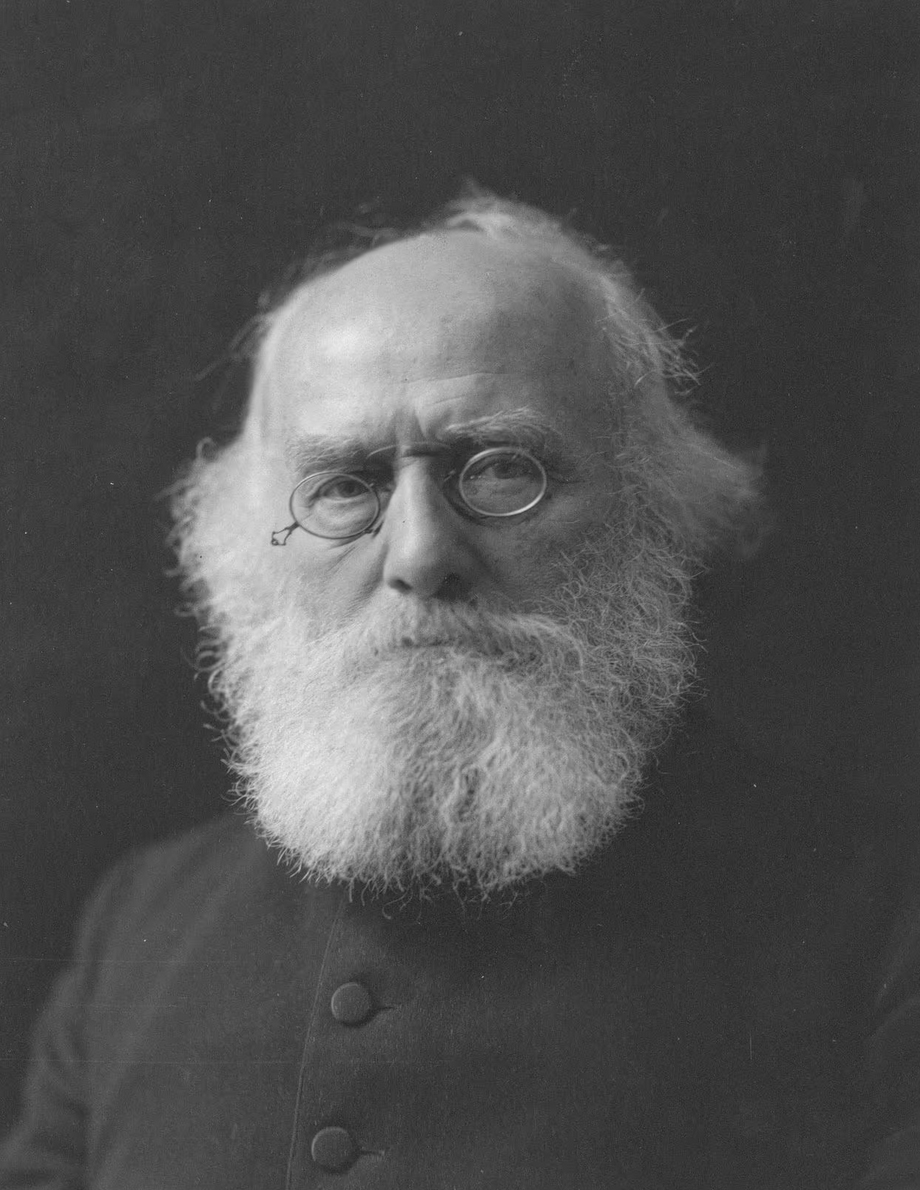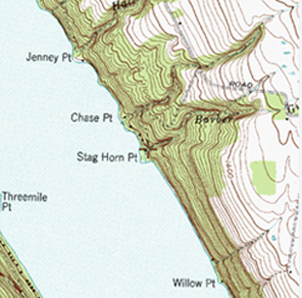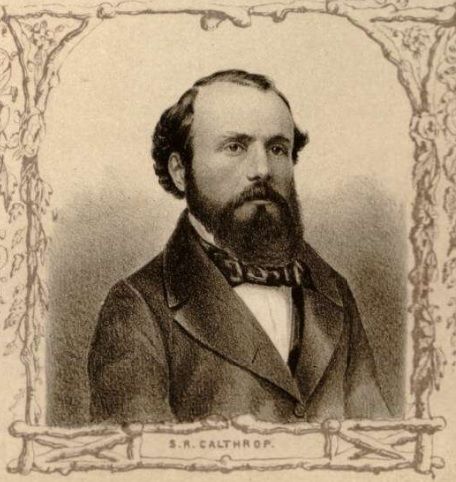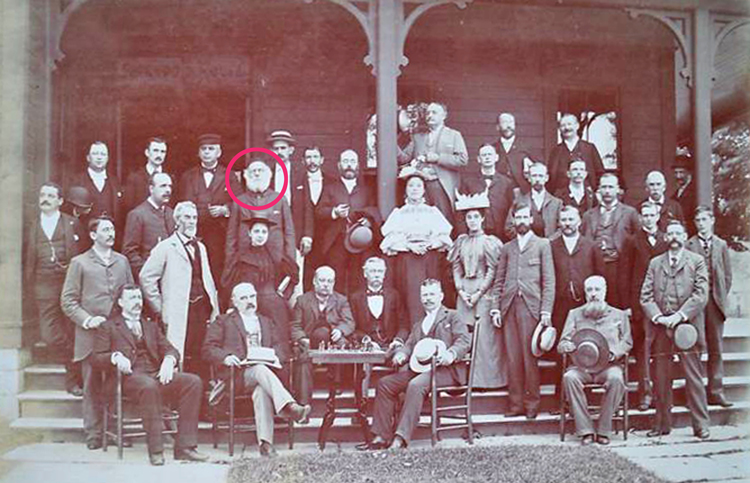
In Skaneateles: History of Its Earliest Settlement and Reminiscences of Later Times (1902), author E.N. Leslie makes no mention of the Rev. Samuel Calthrop. Published in the same year, George Collin’s History: Town of Spafford gives Calthrop one passing mention as a cottager, and nothing more. And yet Calthrop is one of the most accomplished and interesting individuals to spend time on the shores of Skaneateles Lake.
The Rev. Calthrop’s day job was in Syracuse as minister at the May Memorial Unitarian Universalist Church, from 1868 to 1911. Born in England, he had studied for the priesthood at Trinity College, Cambridge, but was not granted a degree because he would not accept the “Thirty-nine Articles of Religion” of the Church of England. The greater freedom of America and the Unitarian faith called to him.
He settled in the U.S. in 1853 and, after teaching for six years, he was ordained in the Unitarian ministry. In 1868, he came to Syracuse, as the successor to the Rev. Samuel May. From 1871 onward, he lived about two miles south of the city, on Primrose Hill, which was named for his wife, Elizabeth Primrose. It was an idyllic setting, described by a student who recalled his first visit:
“A long avenue winding around a charming, wooded hill. A gabled red brick house with high, diamond-paned windows opening in the middle; grapevines spreading down along the slope of the hill toward the railway below… On the lawn was an excellent tennis court and a beautiful great elm which was an unending joy.”
“The door opened and there he stood, something over six feet tall, in clerical garb, a white silk handkerchief about his neck, head thrown back, light blue-gray eyes, kindly twinkling behind gold-rimmed glasses, face and head almost hidden by the large square beard and the mass of curly almost white hair through which but here and there one could detect traces of the warm reddish yellow of former years — a fine figure with broad shoulders, and spirit and vigor written in every line.”
Calthrop’s successor at May Memorial, the Rev. John H. Applebee, wrote:
“Dr. Calthrop was amazingly many-sided. Nothing of human concern was foreign to him. His fund of general information was inexhaustible, and there was nothing about which he had not some interesting and stimulating comment. He was a great preacher and, perhaps, even a greater teacher. He was a profound classical scholar and a scientist deeply versed in geology, botany and astronomy. He needed no text when teaching Homer and Virgil for he knew much of The Iliad and The Aeneid by heart.”
On the Lake

As for Rev. Calthrop’s coming to Skaneateles, we have clues from the local press as to when and why. In July of 1880, William Beauchamp wrote:
“At Stag-horn Point, Col. Jenney of Syracuse has a large camp, and a boat came off to get the mail. A red tin canister containing it was thrown into the water, and quickly picked up. Other camps were passed, though none so large…”
Col. Edwin Jenney was a member of Calthrop’s congregation at May Memorial; I would not be surprised to learn that Calthrop was among this “large” party of campers, or that he was told of the point’s charms when the campers returned to Syracuse.
In May of 1882, the local press reported “Stag Horn Point, Skaneateles Lake, has been purchased by Syracuse parties, who are building residences and a dock there.”
Two months later, “Skaneateles Lake is attracting a large number of visitors and already quite a number of Syracusans have taken up their abode for the summer along its inviting shores… Rev. Dr. Calthrop is at Stag Horn Point and is preparing for a large party of Syracusans who are to follow him soon.”
Among the things Caltrop loved at Primrose Cottage were rowing, sailing and fishing. And he drew lessons from all of them. In 1905, he wrote:
“Some years ago I saw, near the shore of my beloved Skaneateles Lake, a very large black bass lying motionless about three feet from the top of the water. It paid no attention to my boat, so I gently put down my oar to touch it. It quietly moved just out of reach, and as quietly came back again as soon as my oar was removed. This it did again and again. Just below it, it had cleared a space of some feet at the bottom of the lake where it had laid its eggs. It was watching its beloved young, and its mother-love had cast out all fear! It would have been a sin against all motherhood to touch that fish. Good Saint Francis of Assisi used to preach the gospel to his brothers, the fishes. I wonder if he knew at all how closely that which was best in them was akin to that which was best in him.”
The Rev. Calthrop was famous for inviting friends, neighbors and members of his congregation to Primrose Hill for “basket sociables,” and so it was no surprise when he invited members of the New York State Chess Association, holding its mid-summer meetings at the Packwood House, to his summer home at Stag Horn Point.
Chess
In England, Calthrop began his interest in chess by studying openings with a childhood friend. At Trinity College, he was noted as one of the best players in the school. After his move to America, Calthrop was called “the most brilliant and original amateur who has ever yet arisen in the provinces” by Howard Staunton, for whom the Staunton pattern of chess pieces is named.

In 1857, Calthrop was named as one of the best 16 players in America and invited to play in the first American Chess Congress in New York City. After the tournament, the winner, Paul Morphy, one of the greatest players ever, played “casual” games with the others, including a game with Calthrop. (Morphy won.)
In 1889, when the New York State Chess Association scheduled its mid-summer tourney in Skaneateles, the local press reported, “The Rev. S.R. Calthrop of Syracuse is at his summer home ‘Stag Horn’ on Skaneateles Lake. He is studying in rustic retirement, and rubbing off the rust from his armor in preparation for the tourney.”
The rust removed, Calthrop did not win the tourney, but he did take a game “remarkable for its brilliancy” from Samuel Lipschütz, then the New York State and U.S. champion. More famously, he hosted the entire party at Primrose Cottage. The steamer Ossahinta was chartered for the trip; sandwiches, non-intoxicating drinks and ice cream were served by Elizabeth Calthrop.
The Albany Sunday Express reported, “The exercises of Tuesday afternoon up the lake were enjoyable; the visit to Dr. Calthrop’s summer camp at Stag Horn Point was particularly so; the genial philosopher and scientist is never more admirable than when entertaining guests. By the aid of his telescope he conjured up a spot on the sun and exhibited it to an appreciative audience; and some of our fourth-class players saw a great deal farther than when they were playing chess.” (An avid astronomer, Calthrop was one of the first to explore the idea that sunspots affect the weather on Earth.)

In 1891, the tourney returned to Skaneateles, and this time Calthrop made it into the group photo. Calthrop won a game against Albert Hodges, who would go on to become the New York and U.S. champion. He again hosted the players, as reported by the English-Irish-American-Canadian player, William Pollock, a resident of Baltimore and winner of the Irish Championship. Pollack was a colorful character known for enjoying the creation of brilliant combinations more than actually winning.
In a newspaper column Pollock wrote, “A large party enjoyed a most glorious excursion on the lake, feasting and conversation being varied with minstrel songs, chess, cards, a visit to Dr. Calthrop’s mountain camp… the trip was found to be an admirable antidote to the somewhat fierce festivities of the previous night.”
Among the diversions that day, Calthrop took William Steinitz, the world champion of chess, out for a row onto the lake so that he might see “the Swiss like scenery.”
***
In 1901, Calthrop suffered a broken leg and spent much of the summer on the couch at Primrose Hill. But, the Unitarian Unity magazine reported, “As soon as it was practicable to remove the plaster cast from the injured member he went down to his beloved camp at Staghorn Point on the shores of Skaneateles Lake, from which now come cheerful reports, showing that he is gradually recovering the use of the stiffened knee. He can now get in and out of his boat unassisted and is displaying his wonted skills as a fisherman.”
In later years, the cottage was opened by his daughter, Edith Calthrop Bump, and her family.
Samuel Calthrop died quietly of pneumonia on May 11, 1917. He was 87 years old. His funeral was at May Memorial, the church he had served; it was decorated with flowers, roses, daffodils, tulips, violets and lilies, arranged in no order, but “running riot everywhere.”
***
And what became of Primrose Hill?
In 1906, Edward I. Rice had a “coal pocket” built on a portion of the site, a structure of reinforced concrete which would hold 1,500 tons of coal to fuel the trains passing along the Lackawanna railroad tracks.
In 1910, the forest portion of the estate was clearcut; Patrick R. Kelly bought the land and supervised its clearance. Two of the oak trees were found to be more than 150 years old. “To the suggestion that those old trees are mighty valuable, he said he would give them away to anybody who would take them away—stumps and all.”
In 1922, the house was sold to C.W. Wiggins; the Syracuse Journal noted, “He will wreck it for the material. Then Miss Elizabeth T. Calthrop and Miss Anne Calthrop, daughters of the Calthrops, who have been the sole occupants of the house since the deaths of their parents in 1917, will sell the sand which the huge mound consists of and divide the property into building lots.”
The only traces left today are Calthrop and Primrose Avenues on the south side of Syracuse, between South Salina Street on the east and McKinley Park on the west.
***
Sources & Further Reading
“The Good Doctors Calthrop, Applebee and Argow: A Sermon by the Rev. John C. Fuller, June 1, 1969”
“The Boyhood of Rev. Samuel Robert Calthrop, Compiled by His Daughter, Edith Calthrop Bump”
“Recollections of the Old Master,” Harvard Graduates’ Magazine, March 1923
“Calthrop, Samuel R.” by the Rev. John H. Applebee and Dr. William Sydney Thayer
“On Skaneateles Lake” by William Beauchamp, Baldwinsville Gazette, July 29, 1880
God and His World: Sermons on Evolution (1905) by the Rev. Samuel Calthrop
“Chess in Skaneateles, Part 1”
“Vacation Notes” in Unity, September 19, 1901

Great story. Thanks
FASCINATING! Please keep the articles coming, I enjoy them so much!